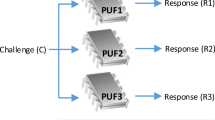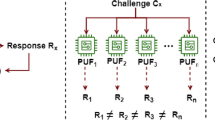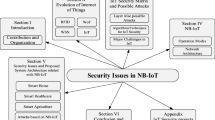Abstract
In the IEEE S&P 2017, Ronen et al. exploited side-channel power analysis (SCPA) and approximately 5 000 power traces to recover the global AES-CCM key that Philip Hue lamps use to decrypt and authenticate new firmware. Based on the recovered key, the attacker could create a malicious firmware update and load it to Philip Hue lamps to cause Internet of Things (IoT) security issues. Inspired by the work of Ronen et al., we propose an AES-CCM-based firmware update scheme against SCPA and denial of service (DoS) attacks. The proposed scheme applied in IoT terminal devices includes two aspects of design (i.e., bootloader and application layer). Firstly, in the bootloader, the number of updates per unit time is limited to prevent the attacker from acquiring a sufficient number of useful traces in a short time, which can effectively counter an SCPA attack. Secondly, in the application layer, using the proposed handshake protocol, the IoT device can access the IoT server to regain update permission, which can defend against DoS attacks. Moreover, on the STM32F405+M25P40 hardware platform, we implement Philips’ and the proposed modified schemes. Experimental results show that compared with the firmware update scheme of Philips Hue smart lamps, the proposed scheme additionally requires only 2.35 KB of Flash memory and a maximum of 0.32 s update time to effectively enhance the security of the AES-CCM-based firmware update process.
Similar content being viewed by others
References
Li W, Song H, Zeng F. Policy-based secure and trustworthy sensing for Internet of things in smart cities. IEEE Internet of Things Journal, 2018, 5(2): 716-723. https://doi.org/10.1109/JIOT.2017.2720635.
Patton M, Gross E, Chinn R et al. Uninvited connections: A study of vulnerable devices on the internet of things (IoT). In Proc. the 2014 IEEE Joint Intelligence and Security Informatics Conference, Sept. 2014, pp.232-235. https://doi.org/10.1109/JISIC.2014.43.
Antonakakis M, April T, Bailey M et al. Understanding the Mirai Botnet. In Proc. the 26th USENIX Security Symposium, Aug. 2017, pp.1093-1110.
Kim J, Chou P H. Energy-efficient progressive remote update for flash-based firmware of networked embedded systems. ACM Transactions on Design Automation of Electronic Systems, 2010, 16(1): Article No. 7. https://doi.org/10.1145/1870109.1870116.
Wurm J, Hoang K, Arias O et al. Security analysis on consumer and industrial IoT devices. In Proc. the 21st Asia and South Pacific Design Automation Conference, Jan. 2016, pp.519-524. https://doi.org/10.1109/ASPDAC.2016.7428064.
Radanliev P, De Roure D, Cannady S et al. Economic impact of IoT cyber risk — Analysing past and present to predict the future developments in IoT risk analysis and IoT cyber insurance. In Proc. the 2018 Living in the Internet of Things: Cybersecurity of the IoT, Mar. 2018, Article No. 3. https://doi.org/10.1049/cp.2018.0003.
Cui A, Costello M, Stolfo S. When firmware modifications attack: A case study of embedded exploitation. In Proc. the 20th Annual Network and Distributed System Security Symposium, Feb. 2013. https://doi.org/10.7916/D8P55NKB.
Ronen E, Shamir A, Weingarten A O, O’Flynn C. IoT goes nuclear: Creating a ZigBee chain reaction. In Proc. the 2017 IEEE Symposium on Security and Privacy, May 2017, pp.195-212. https://doi.org/10.1109/SP.2017.14.
Idrees M S, Schweppe H, Roudier Y et al. Secure automotive on-board protocols: A case of over-the-air firmware updates. In Proc. the 3rd Int. Workshop. Communication Technologies for Vehicles, Mar. 2011, pp.224-238. https://doi.org/10.1007/978-3-642-19786-4_20.
Steger M, Karner M, Hillebrand J et al. Applicability of IEEE 802.11s for automotive wireless software updates. In Proc. the 13th International Conference on Telecommunications, Jul. 2015. https://doi.org/10.1109/ConTEL.2015.7231190.
Prada-Delgado M A, Vázquez-Reyes A, Baturone I. Trustworthy firmware update for Internet-of-Thing devices using physical unclonable functions. In Proc. the 2017 Global Internet of Things Summit, Jun. 2017. https://doi.org/10.1109/GIOTS.2017.8016282.
Choi B C, Lee S H, Na J C, Lee J H. Secure firmware validation and update for consumer devices in home networking. IEEE Transactions on Consumer Electronics, 2016, 62(1): 39-44. https://doi.org/10.1109/TCE.2016.7448561.
Yohan A, Lo N W. An over-the-blockchain firmware update framework for IoT devices. In Proc. the 2018 IEEE Conference on Dependable and Secure Computing, Dec. 2018. https://doi.org/10.1109/DESEC.2018.8625164.
Lee B, Lee J H. Blockchain-based secure firmware update for embedded devices in an Internet of Things environment. The Journal of Supercomputing, 2017, 73(3): 1152-1167. https://doi.org/10.1007/s11227-016-1870-0.
Asokan N, Nyman N, Rattanavipanon N et al. ASSURED: Architecture for secure software update of realistic embedded devices. IEEE Transactions on Computer-Aided Design of Integrated Circuits and Systems, 2018, 37(11): 2290-2300. https://doi.org/10.1109/TCAD.2018.2858422.
O’Flynn C, Chen Z. Side channel power analysis of an AES-256 bootloader. In Proc. the 28th IEEE Canadian Conference on Electrical and Computer Engineering, May 2015, pp.750-755. https://doi.org/10.1109/CCECE.2015.7129369.
Guillen O M, De Santis F, Brederlow R, Sigl G. Towards side-channel secure firmware updates. In Proc. the 9th Int. Symp. Foundations and Practice of Security, Oct. 2016, pp.345-360.
Dworkin M. Recommendation for block cipher modes of operation: The CCM mode for authentication and confidentiality. Technical Report, National Institute of Standards and Technology, 2004. https://nvlp-ubs.nist.gov/nistpubs/Legacy/SP/nistspecialpublication8-00-38c.pdf, Dec. 2019.
IEEE. IEEE Standard for Information technology—Telecommunications and information exchange between systems — Local and metropolitan area networks — Specific requirements — Part 11: Wireless LAN Medium Access Control (MAC) and Physical Layer (PHY) Specifications. IEEE Std 802.11, Jul. 2004.
Dworkin M. Recommendation for block cipher modes of operation: Methods and techniques. Technical Report, National Institute of Standards and Technology, 2001. https://nvlpubs.nist.gov/nistpubs/Legacy/SP/nistspecial-publication800-38a.pdf, Dec. 2019.
Kocher P, Jaffe J, Jun B. Differential power analysis. In Proc. the 19th Annual Int. Cryptology Conf., Aug. 1999, pp.388-397. https://doi.org/10.1007/3-540-48405-1_25.
Brier E, Clavier C, Olivier F. Correlation power analysis with a leakage model. In Proc. the 6th International Workshop on Cryptographic Hardware and Embedded Systems, Aug. 2004, pp.16-29. https://doi.org/10.1007/978-3-540-28632-5_2.
Author information
Authors and Affiliations
Corresponding author
Supplementary Information
ESM 1
(PDF 349 kb)
Rights and permissions
About this article
Cite this article
Fan, YH., Wang, MQ., Li, YB. et al. A Secure IoT Firmware Update Scheme Against SCPA and DoS Attacks. J. Comput. Sci. Technol. 36, 419–433 (2021). https://doi.org/10.1007/s11390-020-9831-8
Received:
Accepted:
Published:
Issue Date:
DOI: https://doi.org/10.1007/s11390-020-9831-8




